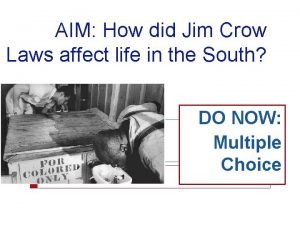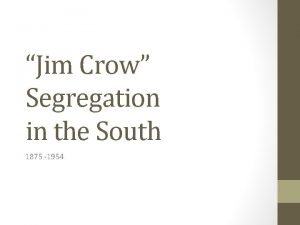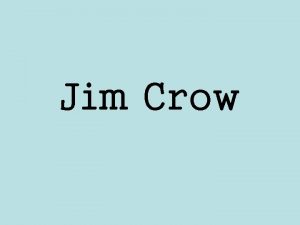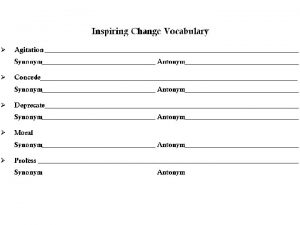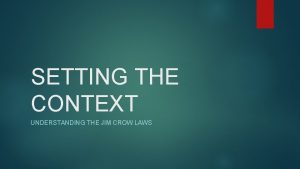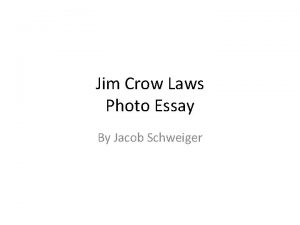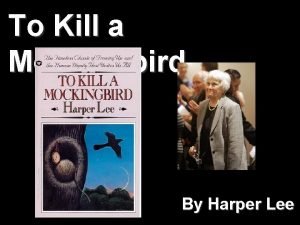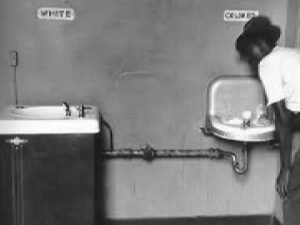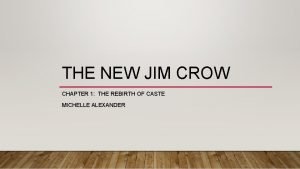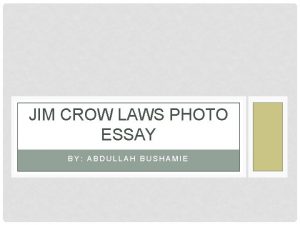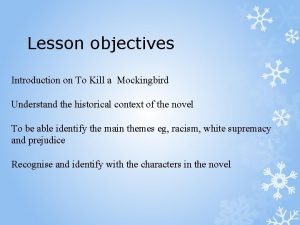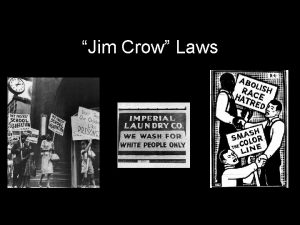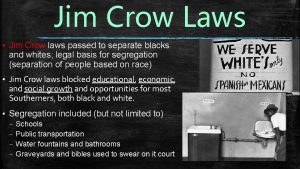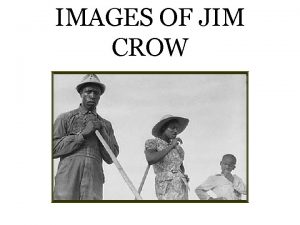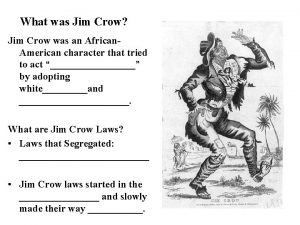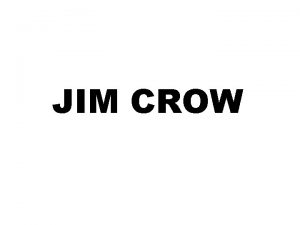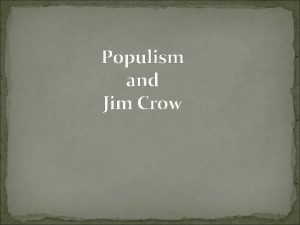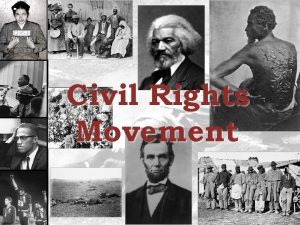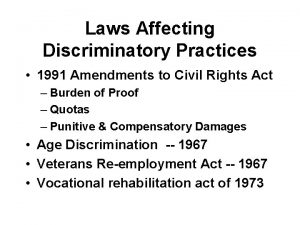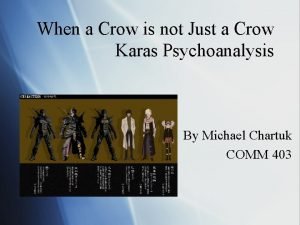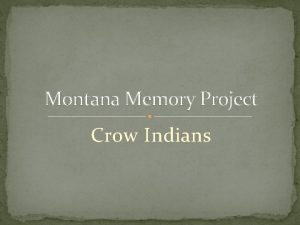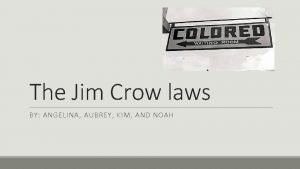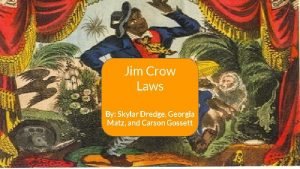Jim Crow Laws Many of the discriminatory Jim


























- Slides: 26


Jim Crow Laws Many of the discriminatory Jim Crow laws were enacted to support racial segregation in everyday life. They required black and white people to use separate water fountains, public schools, public restrooms, restaurants, public libraries, buses and rail cars.



The term Jim Crow comes from the minstrel song Who was “Jump Jim Crow" written in 1828 and performed by Thomas Dartmouth "Daddy" Rice, a white song and dance man, who first popularized Black Face. The song and blackface itself were an immediate hit. A caricature of a shabbily dressed rural black, "Jim Crow" became a standard character in minstrel shows. Jim Crow?



What happens if you break a law? The Jim Crow Laws justified and perpetuated the use of lynching against African Americans, particularly by groups such as the Klux Klan (KKK).

Founded by former Confederate soldiers after the Civil War(1861 -1865) the Ku Klux Klan (KKK) used violence and intimidation to prevent blacks from voting, holding political office and attending school.

Strange Fruit Southern trees bear strange fruit, Blood on the leaves and blood at the root, Black bodies swinging in the southern breeze, Strange fruit hanging from the poplar trees. Pastoral scene of the gallant south, The bulging eyes and the twisted mouth, Scent of magnolias, sweet and fresh, Then the sudden smell of burning flesh. Here is fruit for the crows to pluck, For the rain to gather, for the wind to suck, For the sun to rot, for the trees to drop, Here is a strange and bitter crop.

• Emmett Till Clip Emmett Till In August 1955, Mamie Till-Mobley of Chicago sent her only child, 14 year-old Emmett Louis Till, to visit relatives in the Mississippi Delta. Little did she know that only 8 days later, Emmett would be abducted from his Great-Uncle’s home, brutally beaten and murdered for one of the oldest Southern taboos: whistling at a white woman in public. The murderers were soon arrested but later acquitted of murder by an all-white, all-male jury.

To Kill A Mockingbird •

Harper Lee • As a child, Harper Lee was an unruly tomboy. She fought on the playground. She talked back to teachers. She was bored with school and resisted any sort of conformity. The character of Scout in To Kill a Mockingbird would have liked her. In high school Lee was fortunate to have a gifted English teacher, Gladys Watson Burkett, who introduced her to challenging literature and the rigors of writing well. Lee loved 19 th-century British authors best, and once said that her ambition was to become "the Jane Austen of south Alabama. "

The Background • The story is about a young girl named Scout who witnesses a town’s mistreatment of people. • The story is told from the young girl’s point of view. • The MAIN characters are good people witnessing prejudice.

• The young girl describes the prejudice honestly and at times descriptively. • The language of the novel is at times vernacular – meaning that the language includes slang words and even derogatory words which were used by prejudiced people.

• Some of the prejudice described in the story includes: white against black poor against rich girls against boys black against white rich against poor boys against girls • The story describes the lifestyle of southern America in the post-Depression era of the late 1930 s. • The story describes the judicial system of Alabama and the country in the 1930 s.

Scout Finch • • Jean Louise “Scout” Finch - Narrator of the story Almost 6 when the story starts Lively, intelligent girl (taught herself to read very young). • Strong will and a quick temper • Tom-boy, prefers to hang out with Jem and Dill instead of girls. • Very open-minded

Atticus Finch • Lawyer in Maycomb, Alabama • Widower raising 2 children • Modest and tactful, very respected community member. • Demands honesty and courtesy from his children

Jeremy Atticus “Jem” Finch • Scouts older brother • Tries to act like Atticus-is calm and reasonable • Usually restrains his anger, but sometimes loosed control of it

Charles Baker “Dill” Harris • Friend of Jem and Scout • Comes to Maycomb each summer to stay with his Aunt Rachel • Has no father, feels un -wanted and un-loved by his mother • Very charismatic

Arthur “Boo” Radley • Neighbor to the Finch’s-mostley known due to rumors • Has not been seen outdoors since he was a teenager

Bob Ewell • Poor Farmer and widower • Makes no attempt to be a good personspends all of his welfare on alcohol • Abuses his children

Mayella Ewell • Bob Ewell’s 19 year old daughter • Raises her younger brothers and sisters • Lonely • Uneducated

Tom Robinson • Black man accused of raping a white woman • Has a wife and children • Helpful and kind

Supporting Characters • Aunt Alexandria. Atticus’s younger sistercomes to help raise Scout • Miss Maudie- Children’s favorite neighbor, supports Atticus • Calpurnia- The Finch’s cook. Acts as a mother figure. • Link Dees- Tom Robinson’s employer. Shows that some people are not prejudice. • Mrs. Dubose- An elderly, ill-tempered, racist woman who lives near the Finches. • Nathan Radley- Boo Radley’s older brother

Supporting Characters • Heck Tate- Sheriff of Maycomb, AL. • Mr. Underwood. Journalist and publisher of the town’s newspaper • Mr. Dolphus Raymondwhite man who has a black wife and “mixed” children. Seen as the town drunk. • Mr. Walter Cunningham-poor farmer. Is seen as part of the lynch mob, but shows his human qualities. • Walter Cunninghamclassmate of scouts who cannot afford to buy lunch.
 Jim crow laws
Jim crow laws Racial etiquette region
Racial etiquette region Main idea
Main idea Jim crow laws definition
Jim crow laws definition Jim crow laws
Jim crow laws Rennasa
Rennasa Directive counselling steps
Directive counselling steps Jim crow shorthand for separation
Jim crow shorthand for separation The new jim crow chapter 2
The new jim crow chapter 2 Jim crow pictures
Jim crow pictures Apartheid vs jim crow venn diagram
Apartheid vs jim crow venn diagram Segregation images
Segregation images Jim crow character
Jim crow character Jim crow
Jim crow Understanding jim crow (setting the setting)
Understanding jim crow (setting the setting) Jim crow photo essay
Jim crow photo essay Jim crow acrostic poem
Jim crow acrostic poem Boo radley character traits
Boo radley character traits Louisiana 1918 poll tax receipt
Louisiana 1918 poll tax receipt The new jim crow chapter 1
The new jim crow chapter 1 Jim crow photo essay
Jim crow photo essay Symbols of to kill a mockingbird
Symbols of to kill a mockingbird Discriminatory pricing rule
Discriminatory pricing rule Non-discriminatory evaluation
Non-discriminatory evaluation Stimulus control occurs when
Stimulus control occurs when Charles de secondat
Charles de secondat Food web energy pyramid
Food web energy pyramid



